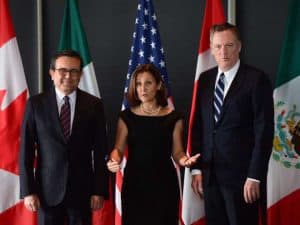May 14th. Trade correspondent L.C. reports:
NAFTA

Canada’s Minister of Foreign Affairs Chrystia Freeland, Mexico’s Secretary of Economy Ildefonso Guajardo Villarreal, left, and Ambassador Robert E. Lighthizer, USTR (Sean Kilpatrick/The Canadian Press)
Important developments in the NAFTA renegotiation took place this week:
- House Speaker Paul Ryan (R-WI) announced that he considers May 17th the final day on which the Administration can notify Congress that it has essentially finished the renegotiation and intends to sign the agreement — if the current Congress is to vote on it;
- Legislators of both parties warned the Administration against its contemplated move to pressure Congress to approve NAFTA 2.0 by giving a six-month withdrawal notice at the same time as it submits the agreement;
- A bill was introduced in the House that would give Congress a veto over Administration efforts to change US trade agreements and policies;
- A private meeting between auto executives and President Trump did not go well.
Ryan’s May 17th Deadline
The deadline Ryan referred to is set by the Trade Promotion Authority (TPA) law. It requires that a trade agreement can’t be signed until ninety calendar days after a notice of intent to sign has been sent to Congress. It also requires that thirty days later (sixty days before signing) the text of the full, final agreement has to be published by the US Trade Representative (USTR). And it requires that within three and a half months after the signing (105 days), the US International Trade Commission (ITC) has to present Congress a report on the expected economic impact of the agreement on the whole economy and on specific sectors. If these and several other timelines are met, the agreement-implementing bill can be sent to Congress and be acted on under fast-track procedures.
NAFTA 2.0 vs. NAFTA 0.0
The outcry from Congress intensified this week from House and Senate members of both parties against the White House’s expected tactic of giving a six-month NAFTA withdrawal notice at the same time as it submits the renegotiated agreement to Congress. The point of the tactic would be to pressure Congress to vote for NAFTA 2.0 even if members don’t like it — by making the alternative not keeping the current NAFTA 1.0, but having no NAFTA.
But as we have previously reported, the President does not have the sole authority to withdraw; he would also need congressional agreement. Nevertheless, members of Congress have been denouncing the President and USTR Lighthizer for even threatening to use this tactic – referring to it as blackmail, hostage-taking, and strong-arming. These points were made bluntly in a May 10th Wall Street Journal op-ed by Sen. Pat Toomey (R-PA) titled “Don’t Try to Blackmail Us on NAFTA, Mr. President” and in a May 9th letter to Trump from Reps. Sander Levin (D-MI) and Ron Kind (D-WI), both members of the Ways & Means Trade Subcommittee.
The TAP bill as a congressional check on unilateral trade moves by the executive branch
A bipartisan group of four House members introduced a bill on May 10th – the Trade Authority Protection Act (TAP) – to give Congress the power to nullify unilateral trade actions by the President. It would require that the President submit to Congress a report on any actions, such as withdrawing from an agreement or imposing tariffs unilaterally. The report must describe the actions and provide an analysis of their likely economic impact as well as any anticipated retaliation by trading partners. Congress would have the right to veto the actions through a joint resolution of disapproval within 60 days of receiving the report. The process is modeled on that used in the Congressional Review Act.
TAP was introduced by Reps. Ron Kind (D-WI), Gregory Meeks (D-NY), Ralph Norman (R-NC), and Charlie Dent (R-PA).
It is possible that the bill could gain momentum if the President spurns Congress’s warnings against trying to withdraw from NAFTA or if the Section 232 and 301 processes result in enough harm to the economy – from the tariffs on imports and the foreign retaliation – that legislators come under pressure from constituents to take action.
The House bill’s two Democratic sponsors, Kind and Meeks, are members of the centrist pro-trade New Democrat Coalition (Kind is a past chairman). The effort may in part be a response to the lack of respect Lighthizer has shown to the group. It requested a meeting with him, which he set and then cancelled and didn’t re-set. Many observers believe a NAFTA 2.0 can’t get through Congress without strong support from the NDC. Its members have made up most of the Democratic votes for recent trade agreements and have been seeking to work with the USTR on the NAFTA renegotiation, without getting a positive response.
“Tense” meeting with auto executives
A May 11th meeting the President held at the White House with chief executives from all the major US and foreign auto companies has been described as “tense.” The formal topic of the meeting was the Administration’s proposed changes to US vehicle emissions regulations, but most of the President’s discussion in the private meeting was reportedly on NAFTA. His reported remarks suggest that he has no misgivings about the demands Lighthizer is pursuing, still considers NAFTA to be negative for the US, and would be happy to have a reason to withdraw.
The President warned Mexico and Canada that they might “lose the golden goose” if they don’t acquiesce to US demands, declaring “NAFTA has been a horrible, horrible disaster for this country and we’ll see if we can make it reasonable.” Perhaps most alarming to his guests, the President (according to the Wall Street Journal) complained that European auto-makers don’t build enough cars in the US, raised the possibility of slapping a 20% tariff on vehicle imports from Europe (presumably meaning cars, since trucks already face a 25% duty), and subjecting them to tougher emissions standards than those placed on domestic vehicles. Trump’s stand is astonishing given the large manufacturing operations of EU and Japanese automakers in the US and the fact that WTO members can’t simply slap new tariffs or regulations on particular countries without justification.
China and ZTE
President Trump has stunned defense and security experts by suddenly offering a major concession to Chinese President Xi Jinping — directing the US Commerce Department to back off from the previously announced penalties imposed on the Chinese telecommunications company ZTE. These included a ban on ZTE purchases of US products. The penalties were imposed in response to ZTE’s evasion of US export controls on Iran and North Korea, as well as fraud and obstruction by ZTE. The restrictions have forced it to shut down most operations, since its products are based on US technology.
There are widespread concerns that China uses its telecom companies for spying. A new bill sponsored by Sen. Marco Rubio (R-FL) would ban US government purchases of ZTE and Huawei technology. Congress has long warned about the espionage threats posed by ZTE and Huawei.
The President’s withdrawal from the Iran nuclear accord and demand that EU companies not trade with Iran, and his claim that it was the North Korea sanctions that wrested concessions from Pyongyang, makes it the more stunning that the President would overturn action against ZTE, a blatant sanctions violator. People knowledgeable about US sanctions law have also expressed surprise that a president would intervene in what is strictly a law-enforcement matter which followed legal procedures. Some also wondered if this could undercut an ongoing Commerce investigation of China’s Huawei.
“Tariffs are not the answer”

Soviet President Gorbachev wanted managed trade (Ron Edmonds-AP)
A news article in today’s Wall Street Journal warns that the dollar’s international dominance and its exchange value will wane if protectionism shifts trade away from the US. An op-ed today in the same paper compared the US Administration’s attempt to establish a regime of managed trade to a similar ill-fated attempt by Gorbachev in 1990.
Opposition to the President’s tariffs is intensifying ahead of a scheduled hearing before the USTR. One important argument is that the tariffs won’t address the objective of changing Chinese behavior. The Chamber of Commerce released its submission, saying that it “supports the Trump administration’s focus on China’s industrial policies and unfair trade practices, but tariffs are not the answer.” A similar view is expressed in many other submissions. In addition, several members of Congress have requested to testify, mainly from states for which agricultural exports are very important. They too will speak against the tariffs and warn of Chinese retaliation.
The National Retail Federation issued a press release saying that the NRF and “more than 100 other associations representing US retailers, manufacturers, farmers, agribusinesses, technology companies and other supply chain stakeholders today submitted comments [to USTR] outlining how the administration’s proposed tariffs… would harm the US economy. The groups urged the administration to instead develop a comprehensive strategy to effectively address China’s unfair trade practices by aligning with Congress and like-minded trading partners…. We believe the proposed tariffs will be counterproductive and undermine your efforts to change China’s policies and practices. There is no way to scope tariffs such that they would not impose direct and indirect costs on US imports, inputs and exports in a way that strains the global supply chain and drives prices up.”
That harm is already being felt. In addition to the recent cancellation of China’s purchases of US soybeans, this week brought reports that China is hindering imports of other US products through border measures centered about enhanced inspections. These have hit items including pork, apples, cherries, citrus, logs, Lincoln cars, US-made German-brand cars, pet food, and cosmetics. The food is subjected to quarantine and intensified, time-consuming scrutiny, and the vehicles to stricter emissions tests. These tougher customs measures aren’t being applied to the same imports from other countries.
Click here to go to the previous Founders Broadsheet post (“Google’s blatant bias shown in search engine comparison”)

Leave a Reply